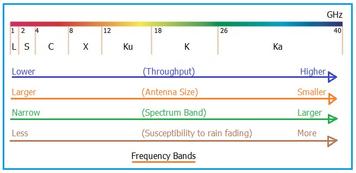
Iridium Satellite System and Constellation Overview
Explore the Iridium satellite system, including its features, constellation details, operating frequencies, and its use in providing global communication via satellite phones.
Advertisement

Explore the Iridium satellite system, including its features, constellation details, operating frequencies, and its use in providing global communication via satellite phones.
This article compares Iridium, Globalstar, and ICO satellite systems, highlighting differences in constellation size, altitude, coverage, and technology.

Explore Ka band frequencies (27-40 GHz), advantages like high-speed data, and applications in satellite communication, radar, and space telescopes.

Explore Ku Band frequency, including its values (12-18 GHz), advantages like smaller antennas and reduced interference, and diverse applications.

Explore the differences between Ku and Ka bands in satellite communication, including their advantages, disadvantages, and applications.
This article compares Ku-band and C-band VSAT systems, outlining their frequencies, benefits, and drawbacks for satellite communication.

Explore the pros and cons of Low Earth Orbit (LEO) for satellite applications, including signal strength, latency, coverage, and atmospheric effects.

Understand the differences between LEOSAR, MEOSAR, and GEOSAR, the three satellite systems of the Cospas-Sarsat search and rescue program.

Explore MCPC (Multiple Channels Per Carrier) in satellite and VSAT: advantages, disadvantages, and its role in efficient bandwidth sharing.

Explore the characteristics, advantages, and disadvantages of Medium Earth Orbit (MEO) satellites, including orbit period, height, lifespan, and coverage requirements.
Explore non-terrestrial networks (NTNs) which use space or aerial platforms to provide connectivity in remote areas and offer resilient communication solutions.
NTN (Non-Terrestrial Network) satellites integrate seamlessly with terrestrial mobile networks, facilitating global connectivity, especially in underserved areas, as specified in 3GPP Release 17.

Explore the differences between Orthomode Transducers (OMT) and Transmit Reject Filters (TRF) in satellite communication, focusing on their function, ports, and frequency handling.

Explore the advantages and disadvantages of orthomode transducers (OMTs), including benefits like polarization duplexing and drawbacks like cost considerations.
A comparison of PAMA, DAMA, and RMA techniques in satellite communication, highlighting their definitions, resource usage, advantages, and disadvantages.

Explore polar orbiting satellites, their characteristics, applications in Earth observation, and examples like SCATSAT-1. Learn about their advantages and disadvantages.

Explore common sources of satellite dish interference, including weather, terrestrial sources, and obstructions, and learn practical mitigation techniques.

Explore the benefits and drawbacks of reusable rockets, including cost reduction, environmental impact, and accessibility to space travel.

Explore RF Low Noise Amplifiers (LNAs) in satellite communication: applications, advantages, manufacturers. Essential for amplifying weak signals, enhancing performance.
Explore various satellite antenna types, including parabolic, horn, phased array, and helical antennas. Learn their advantages, disadvantages, and typical applications.
Advertisement